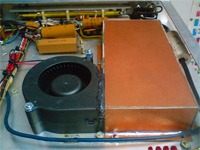Používam starší koncový stupeň Heathkit SB-200. Tento štyridsaťročný PA je osadený dvoma sklenými triódami 572b a funguje skutočne výborne. Roky prevádzky sa však podpísali na zvýšenej hlučnosti ventilátora. Je to 120V motorček s kovovou vrtuľou, ktorá víri vzduch v priestore elektrónok. Nielen hluk, ale aj vibrácie, ktoré ventilátor spôsobuje, sú nepríjemné. Navyše tento spôsob toku vzduchu nie je najvýhodnejší – vzduch sa v priestore elektrónok najmä víri. Výborne napísaný článok o chladení elektrónkových koncových stupňov nájdete na www.ok1kvk.cz
Komerčné riešenie Harbach Electronics
Harbach Electronics ponúka nový ventilátor, ale jeho cena s poštovným je vysoká. Použitie axiálnych ventilátorov by si vyžiadalo veľké mechanické úpravy. V GM Electronic sú však dostupné turbíny s výfukom stranou, tzv. blower SUNON. To umožňuje montáž na subšasi spolu so vzduchovým tunelom. Ten zabezpečí tok vzduchu cez otvory v šasi do priestoru elektrónok a následne odtok cez vrchný kryt. Tým, že vzduch nevíri, ale obteká elektrónky, sa účinnosť chladenia zvýši.
Doplnkový zdroj 12V
SB-200 je potrebné najprv doplniť o zdroj 12V/300mA. Vhodný priestor vznikne po výmene starých elektrolytických kondenzátorov v anódovom zdroji. Nové typy kondenzátorov majú menšie rozmery. Malý sieťový transformátor s usmerňovačom a filtračným kondenzátorom je možné umiestniť nad ne. Iná možnosť je umiestniť spínaný zdroj do priestoru subšasi vedľa turbíny.

Vzduchový tunel
Zdroj je možné využiť aj na obvod soft-startu, resp. napájanie ďalších doplnkov v koncovom stupni. Vzduchový tunel je vlastne box do ktorého ústi vývod z turbíny. Turbína vháňa vzduch dovnútra boxu. Zvýšenie tlaku spôsobuje vytláčanie vzduchu jediným možným smerom – do priestoru elektrónok. Box teda musí zabezpečiť tesné spojenie s turbínou a šasi tak, aby vzduch nemohol unikať inde.
V amatérskych podmienkach je asi najľahšie zospájkovať box z kuprextitu. Ten sa potom priskrutkuje na šasi. Na styčné plochy bola nanesená vrstva silikónu. Silikón taktiež utesňuje prechod turbína – vzduchový tunel.
|
|
|
Regulácia otáčok turbíny
Výhodné je doplniť ešte reguláciu otáčok turbíny. Je zbytočné, aby v kľudovom stave (nezakľúčované, len žhavenie) bežala turbína na plné otáčky. Je možné využiť rôzne spojité elektronické regulátory s komparátormi. Ďalšie riešenie je bimetalový spínač. Kontakty spínača sa preklenú rezistorom takej hodnoty (cca.10ohm), aby sa turbína otáčala pomaly. Spínač sa pripevní na šasi. Pri zvýšení teploty spínač zopne a turbína sa roztočí naplno.
Účinnosť chladenia popísaným spôsobom je badateľne vyššia. V prípade PA s keramickými elektrónkami je použitie turbíny dokonca nutnosťou.


